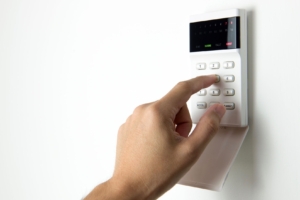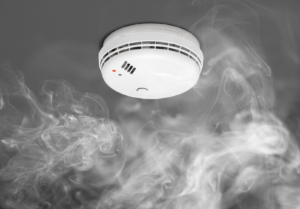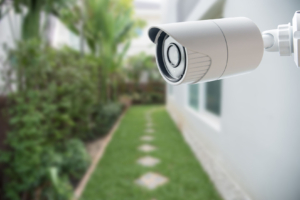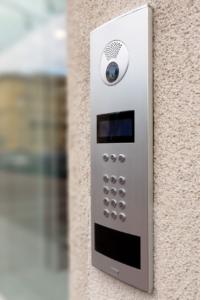 Alarm systems are designed to provide warning of safety and security threats within a protected premises; these threats typically include intrusion, such as burglary and home invasion, in addition to smoke and fire. The system does this by using detectors to monitor zones within the premises; zones are designated points, such as rooms and entrances.
Alarm systems are designed to provide warning of safety and security threats within a protected premises; these threats typically include intrusion, such as burglary and home invasion, in addition to smoke and fire. The system does this by using detectors to monitor zones within the premises; zones are designated points, such as rooms and entrances.
When a detector registers a threat within its zone, the system goes into alarm and takes appropriate action, typically in the form of running local sirens and flashing lights that warn occupants and neighbours of danger, in addition to sending a report to monitoring parties, such as the premises owner/caretaker and/or a remote monitoring centre.
Benefits of an alarm system include:
- Deters intruders by bringing attention to their intrusion and causing a nuisance with high-pitched sirens.
- Provides local and remote warning for returning occupants when their premises have been compromised by intrusion or fire.
- Provides early warning for occupants of home invasion or fire when they are most vulnerable (e.g., sleeping).
- Provides a way for family members to remotely monitor the homes of elderly relatives in addition to simplifying the process of emergency calling.

Did you know smoke detectors can be connected to your alarm system? There are compliant 12 volt photoelectric models that can be connected to your alarm panel; they occupy a zone, much like a motion sensor, but they constantly monitor it, even when the system is disarmed.
When smoke or fire is detected by a connected smoke detector, it registers a fire alarm and the sirens emit a unique fire warning tone; monitoring parties will see that a fire alarm has occurred and can take appropriate action.
Security alarm smoke detectors can be interconnected like standard smoke alarms, but since they are also connected to the alarm panel, more effective warning can be given to occupants and neighbours, due to louder sirens, both internally and externally, plus the provision for additional sirens and the potential to trigger devices for the hearing impaired; additionally, the ability for the alarm system to report to monitoring parties, means that you can know the moment a fire is detected in your premises, instead of finding out hours later when you arrive home to a pile of ash.
Opting for smoke detectors on your alarm system also eliminates the need to run 240V electrical circuits for these low-powered devices, and they are also backed up by the alarm system’s large battery.
All premises should be fitted with smoke detectors that are connected to a monitored alarm system.

Cameras provide a video feed from their installed positions in and around a protected premises. The viewer can watch events happen in real time over a live stream, or they can watch recordings from days, weeks and months past, depending on the size of the storage drive where footage is kept.
Camera systems are employed to combat a range of a threats, from theft to fire, in addition to monitoring the behaviour and movements of employees and customers. Because their applications are so diverse, cameras come in many different forms, from the basic fixed lens cameras of a typical residential installation, to specialty commercial types that can detect the early onset of fire in a warehouse, heat map the movement of customers in a retail store, or even spy on people up to a mile away.
The main benefits of a camera system are (1) the ability to record video and audio footage that may be used as evidence of a crime, and (2) the ability to catch or deter criminals in real time by being able to discreetly oversee their behaviour from afar.
For a home owner, this means you no longer have to leave the relative safety of your house in order to see why the dog is barking at 2 am; you can instantly have eyes on the front, back and sides around the outer perimeter of your house through an app on your phone, a connected TV, or a dedicated surveillance monitor; additionally, with the aid of remote viewing, you can log in and view the cameras whenever you are not at home.
Camera systems typically comprise:
- Cameras; often 1 – 8 megapixel resolution, 2.8 – 3.6 mm fixed lens with ~90 – 100° viewing angle, either analogue (TVI / CVI) or internet protocol (IP).
- Video Recorder; either standard digital (DVR) or network (NVR) with one/multiple 2 – 10 terabyte (TB) hard-drive(s).
- Monitor; either dedicated VGA/HDMI, TV through HDMI, and/or smartphone app.
- Uninterruptible Power Supply (UPS) to provide battery backup and surge protection in case of mains disruption.

Access control systems allow for the electronic control of doors and gates, thereby effectively limiting access based on user credentials in addition to controlling the coming and going of visitors.
For home owners, it can provide a more convenient and safer means of entry to, and egress from, the home than standard key entry; for business owners, it allows them to control the movement of staff and guests through company premises, or to barricade from, or contain, security threats.
Typical access credentials come in the form of PIN codes, radio keyfobs, proximity tokens, encrypted smart cards, biometric markers, and even smartphone apps.
Intercoms
Intercoms are an integral part of many access control systems, and home owners are now making them a part of their electronic security too.
They allow guests to call occupants from the door station, making their presence known without the occupant needing to be near the door to answer. Some intercoms use IP communications, allowing the recipient to use their smartphone to answer calls initiated at the door station, so they can respond to visitors even when they are not home.
Video and audio of each call is recorded, so there is always a record of who has rung the doorbell.
